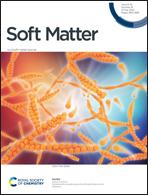Dityrosine-inspired photocrosslinking technique for 3D printing of silk fibroin-based composite hydrogel scaffolds†
Abstract
Photoinduced self-crosslinking technology is a great facilitator of 3D bioprinting of silk fibroin (SF) by allowing rapid solidification of a deliberately formulated SF-based photocrosslinkable bioink. An SF-based, photocrosslinked hydrogel was fabricated with tyramine-modified sodium carboxymethyl cellulose (CMC-Na) as a co-crosslinkable constituent and Ru(bpy)3Cl2 (Ru(II)) and potassium persulfate (KPS) as blue light photoinitiators. Photorheological studies demonstrated that the photocrosslinking and viscoelasticity of the composite could be tuned by varying the relative content of the two constituents. Xanthan gum (XG) was employed in formulating the SF-based photocrosslinkable bioink, and the improved rheological properties and printability were evidenced by the resulting tunable shear-thinning behavior and shear thixotropy. 3D SF-based hydrogel scaffolds with uniform pores with a size of approximately 550 μm × 1000 μm were constructed via extrusion-based printing and a simple 30 s post-photocrosslinking combined process. Furthermore, the CMC-Na incorporated 3D hydrogel scaffolds exhibited sufficient structural strength, adequate filament fineness, and tunable transparency, which shows a promising prospect in the application of tissue engineering and regenerative medicine.



 Please wait while we load your content...
Please wait while we load your content...